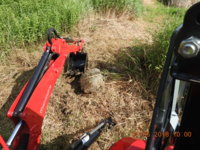- Thread starter
- #1,441
Bruce
Herd Master
Thanks for the tips guys. Whereas I was originally going to start in the area where I have the plywood down since I figured I could make a deeper hole for the fish, I don't think any are alive anymore. So I'm going to start in the SW corner where I basically have a "road" if I cut into the west side a bit with the left side of the bucket. Practice on the shallow end from a very gentle slope.
As to how the pond was built, the deeper (north) end follows the contour of the land, it slopes down both west and north. It starts rising on the west to more visible ledge about 100' from that side of the pond but continues down going north. The berm that makes those sides of the pond are somewhat steep on the outside. NOT thinking of running the tractor up those backward hoping to get the bucket a couple of feet into the pond (horizontally), MAYBE. My GUESS is they dug dirt from what is the "deeper" part and made the berm. No idea if there is any rock or other structural "stuff" in the berms. Whether they went all the way down to ledge everywhere in the pond I have no idea. What I do know is there is decades of dirt/silt/whatever on the bottom now.
As to how the pond was built, the deeper (north) end follows the contour of the land, it slopes down both west and north. It starts rising on the west to more visible ledge about 100' from that side of the pond but continues down going north. The berm that makes those sides of the pond are somewhat steep on the outside. NOT thinking of running the tractor up those backward hoping to get the bucket a couple of feet into the pond (horizontally), MAYBE. My GUESS is they dug dirt from what is the "deeper" part and made the berm. No idea if there is any rock or other structural "stuff" in the berms. Whether they went all the way down to ledge everywhere in the pond I have no idea. What I do know is there is decades of dirt/silt/whatever on the bottom now.

 Or maybe dig a trench around the side of the berm to drain it so the berm integrity isn't disturbed... Then you could bury a large sized drain pipe to the center of the deep end with a valve so next time you won't have to dig to drain it?
Or maybe dig a trench around the side of the berm to drain it so the berm integrity isn't disturbed... Then you could bury a large sized drain pipe to the center of the deep end with a valve so next time you won't have to dig to drain it?





 lol
lol